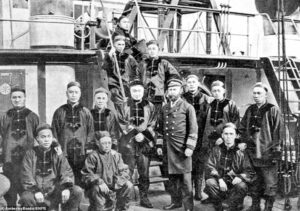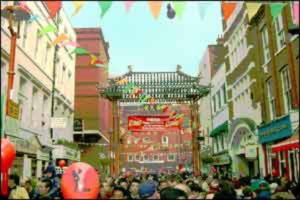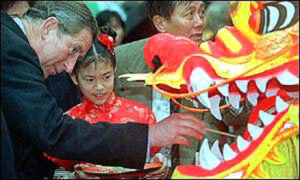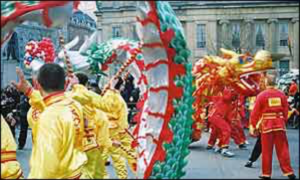The Chinese community is one of the oldest in London. Britain began trade with China in the 17th century, and Chinese sailors arrived in London in 1782 on East India Company ships. This small group lives near the Pennyfield and Limehouse Causeway near the marina. By the end of the 19th century, there were more than 500 Chinese Wharf communities in London; mainly single men and some married British women.

Today, Chinese Londoners are more evenly distributed throughout the city and its boroughs. A large network of Chinese schools and community centres provide support and a way of passing on cultural identity from generation to generation.
London’s first Chinatown sprang up in the 1880s in the Limehouse area of the East End. Chinese seafarers settled there to escape the cramped accommodation provided by the East India Shipping Company. It remained a vibrant community until the Blitz and the post-war decline of the shipping industry led to its demise.

Today, most elderly people live in the Limehouse area. There are only a few street names, restaurants and a Chinese Sunday school to remind us of the early Chinese presence.
The next major wave of migration occurred in the 1960s. Land reform in Hong Kong brought disillusioned agricultural workers to Britain in search of a new livelihood. Many settled in Soho and Bayswater, attracted by the burgeoning trade in Chinese restaurants. By this time, British soldiers from the war in the Far East had created a new customer base for Chinese cuisine. With the success of the restaurants, the area became known as Chinatown.
Chinese seamen were employed on British ships from the 1800s onwards. There were settled Chinese communities in London and Liverpool from the early nineteenth century onwards. The demand for seafarers in the Second World War increased the Chinese population, but most were subsequently repatriated. The first permanent large-scale Chinese settlement occurred in the 1950s, when economic prosperity and labour shortages in the UK led to the relaxation of immigration laws to encourage migration from overseas to the UK and Commonwealth countries.
In the 2011 Census, there were 433,150 Chinese (0.7% of the UK population). According to official figures, the Chinese are now the largest group of immigrants to the UK from any country. However, there is a growing number of undocumented Chinese migrants who face exploitation, poor living conditions and invisibility. In London, for example, some estimates suggest that the Chinese population is twice as large as official figures suggest, due to the large number of undocumented people living there.
There are three main language groups.
The largest is Cantonese, followed by Hakka and Mandarin. There are many versions of Cantonese being spoken. Hokkien, Chiu Chow and Hainan are also spoken. Communities come from Hong Kong, mainland China, Vietnam, Taiwan, Malaysia and Singapore. However, the demographics of the Chinese population are changing as more and more people come from mainland China.
The Chinese community is widely spread across the UK, but is mainly concentrated in London, where it is about half. There are established Chinatowns in major cities such as London, Birmingham, Liverpool, Manchester and Newcastle-upon-Tyne. There are also significant Chinese communities in other major towns such as Edinburgh, Belfast, Cardiff, Bristol, Sheffield, Cambridge and Milton Keynes. There are also Chinese families living in suburbs and small towns throughout the UK.
https://en.unesco.org/courier/2021-4/overseas-chinese-long-history
Changes in London’s Chinatown
Chinatown, located in a prime location in central London, has developed rapidly in recent decades. In addition to traditional Chinese shops and North-South cuisine, there are also some restaurants and bars with Southeast Asian characteristics, making it a tourist hotspot for Chinese and foreign tourists, and a popular destination for overseas Chinese. hometown.

In the early 1800s, some seamen and laborers from southern China settled in London and settled in the Docklands in east London.
In the early 1900s, the British media began to call the Chinese community “China Town”, and the local Chinese called it “Chinatown”. But the British government doesn’t take Chinatown seriously.
In the early 1960s, Chinatown moved westward to the current Juelu Street area.
In 1967, a riot broke out in Hong Kong. Some pro-centre and leftist radicals confronted the British Hong Kong authorities under the influence of the Cultural Revolution in the Mainland. They took to the streets to demonstrate and plant bombs, causing political and social turmoil in Hong Kong. Many Hong Kong people decided to immigrate to Hong Kong. In the UK, some of these immigrants have set up shop near London’s Chinatown, further expanding the scope of London’s Chinatown.

In 1985, London’s Chinatown was officially recognized by the British government, and the late Princess Diana visited Chinatown.
In the Spring Festival of 2000, Prince Charles, the British Crown Prince, performed a finishing touch ceremony in Chinatown.
In 1987, Chinese in London moved from Chinatown to nearby Leicester Square to hold Chinese New Year celebrations, which meant that the status of London’s Chinatown and the Chinese community had been greatly improved.




Leave a Reply